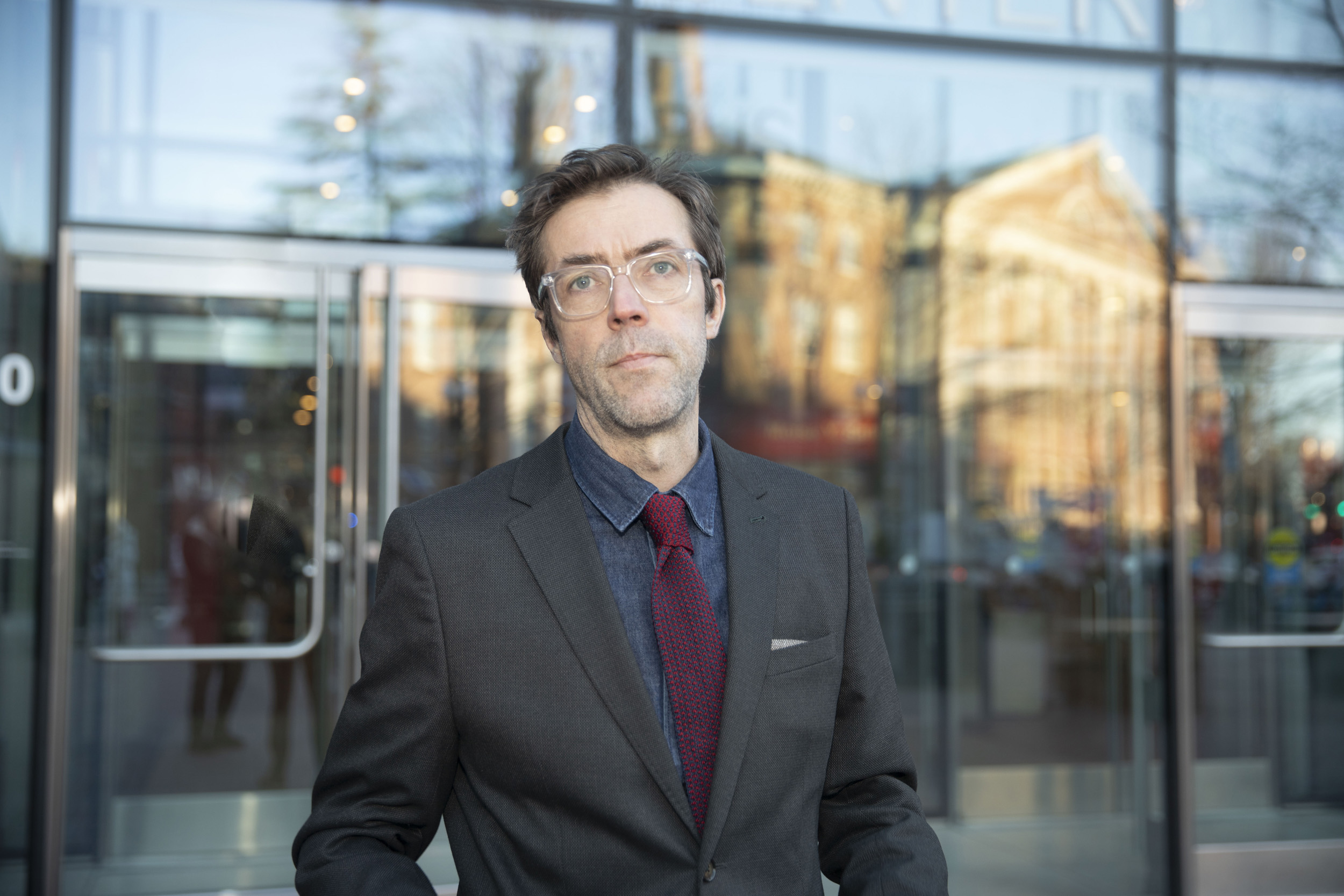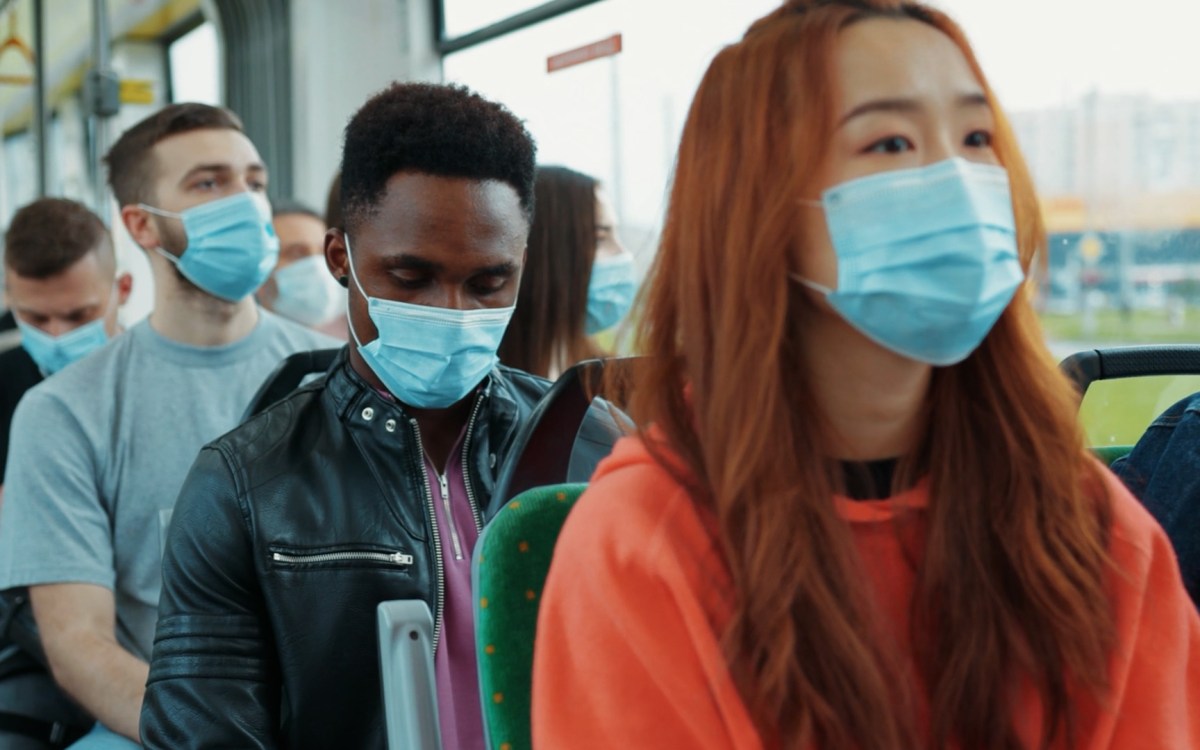
“We are actively getting in the way of future responses to infectious disease emergencies,” epidemiologist William Hanage says.
Kris Snibbe/Harvard Staff Photographer
William Hanage on COVID lessons we haven’t learned
Epidemiologist looks back and ahead
The pandemic has progressed through a now-familiar pattern the past several months, with the latest variant — XBB.1.5 — infecting a lot of people in December and January before starting to fade. Recent data from the Centers for Disease Control and Prevention show that weekly cases and deaths have fallen by roughly half since January, to 226,618 and 2,023, respectively, on March 1. The Gazette spoke with William Hanage, an associate professor of epidemiology at the Harvard T.H. Chan School of Public Health and co-director of the Center for Communicable Disease Dynamics, about the recent surge, the end of the emergency phase, and the persistence of debates around masks and school closings. The interview has been edited for clarity and length.
Q&A
William Hanage
GAZETTE: I saw a lot of people come down with mild cases during the winter surge. Does that reflect the broader COVID experience in recent months?
HANAGE: A lot of people had it and most cases were really quite mild. I strongly suspect that many people didn’t even realize they’d been infected but have gotten additional immunity from infection on top of their vaccines. This is not going to protect them forever, but it is going to have an impact as we emerge from the winter. The context for this, though, is that the death toll is still huge by any pre-2019 standard. The only virus that we routinely expect to cause as many as 50,000 deaths a year in the United States is influenza. And from the end of BA.1 last year to now, we’ve seen 150,000 deaths. That’s three bad flu seasons.
GAZETTE: In the past, when we’ve come off winter surges, things have continued to trend downward. Is that a reasonable expectation for this spring into summer?
HANAGE: Yes, because there’s a lot of people who are immune to infection, though that won’t last forever. That means that fewer people get infected over the course of the winter and fewer people carry it home to their relatives, and that’s even before we start talking about benefits in terms of hospitalizations and deaths.
Using this timeline of weekly U.S. COVID case counts from January 2020-March 2023, can you match letters A-E with the following key moments in the pandemic: Omicron variant peak; height of U.S. vaccination campaign; early deadly period; rise of XBB.1.5 variant; arrival of Alpha variant? Click to expand answer below.
A: The pandemic’s early, deadly peak, when weekly deaths topped 15,000 — in mid-April 2020 — shows as just a low hump in the chart indicating that the disease at this early stage was much more deadly per case than later in the pandemic.
B: The Alpha variant was first detected in the U.S. by the Colorado Department of Health on Dec. 29, 2020, when the CDC designated it a “variant of concern.” Alpha arose in the UK and eventually totaled about 60 percent of U.S. cases before getting squeezed off the U.S. pandemic landscape by a combination of vaccination and competition with the Delta variant.
C: The U.S. vaccination campaign peaked mid-April 2021, when the 7-day moving average of doses reached almost 3.5 million. The following trough – the lowest in the pandemic — is likely due to the effects of vaccination taking hold in the population.
D: The Omicron variant reached its height on Jan. 19, 2022, when the weekly case count climbed to 5.6 million.
E: The most recent peak, December 2022-January 2023, represents the rise of the XBB.1.5 variant. The highly infectious variant rapidly dominated the U.S. It rose from just 2 percent of cases in early December to an early March estimate of 89.6 percent, according to the CDC.
GAZETTE: Do we know more now about how long it takes immunity to wane?
HANAGE: It’s difficult to answer precisely because it all depends: Is it somebody who has been infected? Somebody who’s been vaccinated? And if so, which vaccine have they gotten? What sort of immune system do they have? There is, however, a pretty consistent pattern, which is that you are protected reasonably well from symptomatic infection for a couple of months — maybe as many as four — before it drops away to very little. Being boosted over the winter will provide you with some protection. If you’ve been infected as well, it will last pretty well into the year, new variants allowing. But when we come around to next winter, we’re going to have to revisit things.
GAZETTE: Is the path ahead more of what we’ve been seeing: Milder surges as the years go by?
HANAGE: This is what I think more than 80 to 90 percent of folks in the field would say: Absent a black-swan event like a super variant of some kind, we expect diminishing waves in terms of severe outcomes. It may be a bumpy road sometimes, but overall, we expect the trend to be down because people will keep encountering the virus, they will keep upping their immune response, their T cells will be extremely active at preventing severe illness. Most specialists expect it to become like one of the other seasonal coronaviruses. But we don’t know how long that’s going to take.
GAZETTE: What do you think of President Biden's plan to lift the public health emergency on May 11?
HANAGE: It’s a really stupid idea to schedule the end of a pandemic, because viruses don’t have Outlook calendars. Having said that, it is reasonable to suggest that we need to prepare for the next phase. The big issue with ending the emergency phase is whether it makes it more difficult for folks to get tests, which makes it more difficult to protect those they might infect. It will also make it more difficult for people to access vaccines, which will be most felt by those who are least able to pay and who are more likely to be infected because they’re least able to control exposures. It’s hard enough already to get people boosted, and some will just say, “Oh, we don’t need to be boosted.” That means we will be relying upon repeat infections to build up accumulated immunity in the population. That would happen eventually anyway, but more people will die unnecessarily if it happens this way.
GAZETTE: Are we doing enough, as a society, to think about pandemic lessons?
HANAGE: I don’t think we are, and that’s allowing people to frame narratives in ways that minimize it. We are getting more received wisdom that particular interventions did or didn’t work.
For instance, quality masks as an intervention definitely work for individuals if you are wearing them correctly. Masks at a community level can work, though it does not necessarily mean they will. But by getting into the tizzy that we have over them — for reasons which are mostly not scientific — we are actively getting in the way of future responses to infectious disease emergencies.
Handwashing turned out to not be a big deal for COVID — it doesn’t really spread via the fomite route. But that is not going to help you in the future if you’re worried about Shigella. There’s received wisdom now that school closures were overkill. Even if they were, that would be true only some of the time for this virus, and if we have a flu pandemic next, flu tends to spread a lot in younger kids and age groups in schools.
We’re also getting relitigation of lockdowns — a phrase which I’d never liked. Lockdowns were never expected to completely expel the virus, but they were expected to slow it down, and the actions that were taken in the spring of 2020 meant the virus did not arrive and get started in places like Florida or Arizona until the summer. That meant that when people there got sick, they could be treated with dexamethasone, which, by then, we knew would work because a trial had been done. So those people who got infected then had a better chance than they would have had in the spring. A delay, even if only for a few months, can save a lot of lives. And amazingly, just six months after that, we had multiple vaccines.







